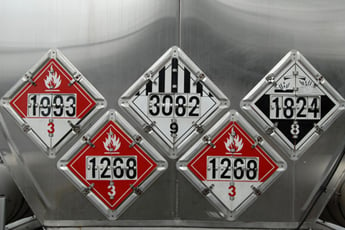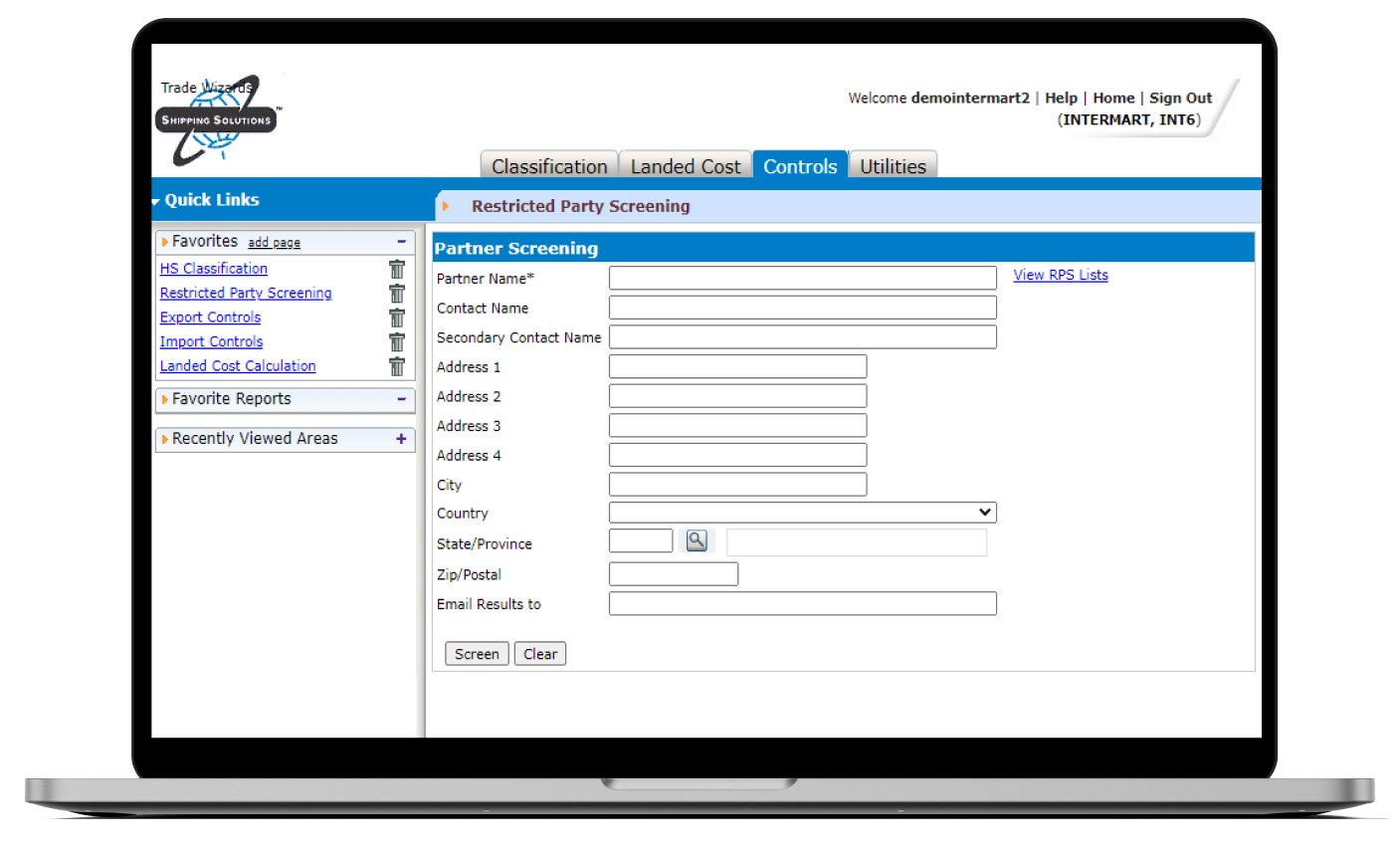The International Trade Blog Export Forms
Hazardous Materials vs. Dangerous Goods: What's the Difference?
On: March 2, 2022 | By:  Robert Smith |
5 min. read
Robert Smith |
5 min. read
 Depending on whether you ship domestically within the U.S. or you import and/or export and ship internationally, the regulations for shipping hazardous materials and dangerous goods have a variety of similarities and differences.
Depending on whether you ship domestically within the U.S. or you import and/or export and ship internationally, the regulations for shipping hazardous materials and dangerous goods have a variety of similarities and differences.
(Check here for information on the appropriate dangerous goods form to include with your shipment.)
The Definition of Hazardous Materials
Domestically, The Hazardous Material Transportation Act (HMTA) was published in 1975. Created to provide adequate protection against the risks to life and property inherent in the transportation of hazardous materials in commerce, the act is broken down into four key areas of compliance and enforcement found in The Code of Federal Regulations (CFR), Title 49:
- Procedures and/or Policies: 49 CFR Parts 101, 106 and 107
- Material Designations: 49 CFR Part 172
- Packaging Requirements: 49 CFR Parts 173, 178, 179 and 180
- Operational Rules: 49 CFR Parts 171, 173, 174, 175, 176 and 177
Without opening the Pandora's box of hazmat regulations found in part 100-177 of CFR49, let's look at the definition found in §171.8:
Hazardous material means a substance or material that the Secretary of Transportation has determined is capable of posing an unreasonable risk to health, safety, and property when transported in commerce, and has designated as hazardous under section 5103 of Federal hazardous materials transportation law (49 U.S.C. 5103). The term includes hazardous substances, hazardous wastes, marine pollutants, elevated temperature materials, materials designated as hazardous in the Hazardous Materials Table (see 49 CFR 172.101), and materials that meet the defining criteria for hazard classes and divisions in part 173 of this subchapter.
A couple of key terms worth noting: property, hazardous substances, and when transported in commerce. We’ll come back to those later.
The Definition of Dangerous Goods
Now let's look at the international definitions of dangerous goods.
For international transportation by air, we have the definition provided by the International Civil Aviation Organization's (ICAO) Technical Instructions for the Safe Transportation of Dangerous Goods by Air and the UN model regulations: "Dangerous goods are articles or substances which are capable of posing a risk to health, safety, property or the environment."
For international transportation by vessel, the International Maritime Organization's (IMO) regulatory definition found in the IMDG Code (International Maritime Dangerous Goods Code) is: "Dangerous goods mean the substances, materials and articles covered by the IMDG Code."
Now, for the average shipper, both hazardous materials (hazmat) and dangerous goods (DGs) terms are fairly interchangeable. However, as we saw with the definition of a hazardous material, the legality of the regulatory wording in the U.S. is very specific when it comes to property and being transported in commerce.
We also see the exclusion of the term "environment" in the U.S. Department of Transportation (DOT) definition. The DOT's jurisdiction over dangerous goods overlaps with the Environmental Protection Agency's (EPA) jurisdiction.
The term "hazardous substances" is an EPA term, and these substances are only regulated for transport if they are shipped in packages that exceed the reportable quantities listed in Appendix A to the table of hazardous materials found in §172.101. Under 40 CFR 302.6, the EPA requires persons in charge of facilities (including transport vehicles, vessels and aircraft) to report any release of a hazardous substance to the DOT's National Response Center if the quantity is equal to or greater than its reportable quantity. They must do so as soon as they have knowledge of the release.
"Property" is another important term especially pertaining to the ownership and possible responsibility involving a hazmat incident. I'm sure corporate lawyers can provide a much clearer explanation of this, but it involves not only the goods being shipped as property, but could also involve where the goods are actually located at any point during transit.
Imagine a consignment of dangerous goods arriving in the U.S. and a serious incident occurs before the importer actually receives the goods. Was there damage to someone's property such as a building or the actual transport unit container or trailer? Who is responsible? The shipper? The carrier or the owner of the goods? Remember the initial purpose of the hazmat transportation act was all about safety.
This is where the regulatory requirements of a shipper relating to the use of hazardous materials terminology such as the correct UN identification numbers, proper shipping names, classification, 24-hour emergency response telephone and other information are used. The shipping papers are also where ownership is controlled and serves as the contract of carriage in business, and it is where an understanding of the correct Incoterms 2020 is vital.
The last term we need to clarify is the use of "when transported in commerce." What happens when you purchase some solvent or oil-based paint at the hardware store? Do you need labels, placards or shipping papers?
No. This is where the manufacturer would need to ensure compliance with the Federal Trade Commission and the Consumer Product Safety Commission and the applicable regulatory references in CFR Title 16 — Commercial Practices in place to protect the end user. We've all seen the scary warning labels for proper storage, usage and disposal of the chemicals we keep under the sink.
Providing Hazmat Training
The key connection here is with the term "when transported in commerce" and how it applies to the hazmat employer. After all, the employer, not the employee, offers the material for transport and is obviously in commerce. The hazmat employer is also responsible for training all the hazmat employees. The training requirements are very specific and must ensure hazmat employees receive adequate training in the following four areas:
- A general awareness of the hazard communication system.
- Safety and how to properly handle the hazardous materials and the need to provide emergency response information. OSHA training can be used to fulfill this if applicable.
- Security awareness and how to develop and maintain a possible security plan, if necessary.
- Function-specific training as it applies to their particular products and modes of transport both domestically and possibly internationally. The alternative use of dangerous goods training can be substituted. For air transport that means training on the ICAO/IATA regulatory requirements; for vessel shipments, that means training according to the IMDG Code.
Compliance with our domestic federal law is mandatory, even for foreign shippers. Although international law is recognized, each country or state may have variations with which the shipper must comply. Guess which country has the most variations? Yup, the U.S.
In CFR49 §171.22 it clearly states: "This subpart authorizes, with certain conditions and limitations, the offering for transportation and the transportation in commerce of hazardous materials in accordance with ... ICAO, IMDG Code, TDG." Note the wording, "with certain conditions and limitations." In other words, when shipping internationally to, through or from the U.S., a shipper must still comply with the domestic hazmat regulations of CFR49.
So while hazardous materials and dangerous goods are somewhat similar, they are also very different depending on what is shipped, from where they originated and where they are going.
CARGOpak Corp. offers on-site training classes in a variety of formats depending on shippers' specific needs for CFR49, ICAO/IATA, TDG and IMDG. Go to the CARGOpak website for more information.
Like what you read? Subscribe today to the International Trade Blog to get the latest news and tips for exporters and importers delivered to your inbox.

About the Author: Robert Smith
Robert M. Smith is CEO and senior instructor of CARGOpak Corp. based in Raleigh, North Carolina. Robert is a dangerous goods and hazmat specialist with more than 30 years experience as a consultant, UN POP designer, and dangerous goods and hazmat training facilitator.
His company consults with clients on various hazmat compliance issues as well as develops and conducts training on dangerous goods/hazmat transport both domestically and internationally through a variety of training formats including web-based, on-site, and public classes. Robert has assisted a broad range of clients in dangerous goods/hazmat transport compliance through the United States, Canada and abroad.


